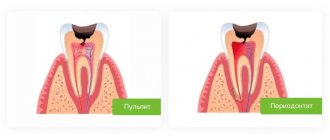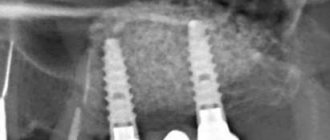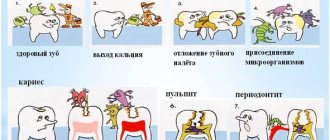Dental caries is usually classified according to different indicators. One of the most widespread is Vinogradova’s classification, according to which there are compensated, subcompensated and decompensated forms of dental caries. We will tell you more about the symptoms and treatment features of different forms of the disease in this article.
In this article
- How does dental caries occur?
- Three forms of dental caries
- Compensated form of caries
- How is compensated caries treated?
- What is subcompensated caries and what are its features?
- Features of decompensated caries
- How is decompensated caries treated?
- Pulpitis as a complication of decompensated caries
- Periodontitis with decompensated caries
- Is it possible to prevent tooth decay?
- Conclusion
How does dental caries occur?
During caries in hard dental tissues, under the influence of organic acids, first areas of enamel demineralization are formed, and then carious cavities. Acids that destroy teeth are produced by cariogenic bacteria. This occurs during the fermentation process of carbohydrates that we consume in food. According to statistics, caries is the most common dental disease; it affects the teeth of people of any age, including the development of baby teeth immediately after teething.
There are different classifications of caries, in particular the Vinogradova classification. According to this division, there are compensated, decompensated and subcompensated caries.
Three forms of dental caries
Vinogradova’s classification is based on the degree of activity of dental caries:
- The compensated course of caries is characterized by the fact that the pathological process develops slowly, carious cavities are hidden under dense dentin, they are rare, and the disease progresses relatively slowly.
- The subcompensated form of the disease develops slightly faster than the compensated form. It is characterized by the appearance of dark areas on the enamel and horizontal spread without penetrating deep into the tooth.
- Decompensated caries is often multiple and spreads very quickly. With such caries, all teeth located near the cheeks are often affected.
The decompensated form is considered the most severe, in most cases accompanied by complications in the form of pulpitis or periodontitis.
Let's talk about all forms of caries in more detail.
Treatment of caries, is it painful to treat?
Caries is a slow-moving pathological process occurring in the hard tissues of teeth, which develops due to the influence of certain external and internal factors.
At the initial stage of development, caries is characterized by focal demineralization of the inorganic part of the tooth enamel and its gradual destruction, affecting the organic matrix, as a result of which this leads to a violation of the integrity of the hard tissues of the tooth with the formation of cavities in the dentin, and in the absence of timely treatment - to the occurrence of inflammatory complications with side of the pulp, leading to periodontitis.
Treatment of caries is completely painless, since all dental procedures are performed under complete anesthesia.
Compensated form of caries
Among all the options for the course of caries, compensated is the most favorable. In this case, the pathological process is sluggish and destroys dental tissue slowly over several years. With compensated caries, remission is possible, which under certain circumstances can result in relapses. According to statistics, compensated caries develops more often than other forms.
It is characterized by smoothed symptoms:
- Acute pain is most often absent;
- the transition of carious lesions from one stage to another occurs smoothly and imperceptibly over several months or even years;
- with compensated caries, a white spot first forms on the enamel, which gradually darkens, becomes rough and less dense. At the dark spot stage, a painful reaction to temperature or taste stimuli is possible;
- The compensated form of caries is characterized by destruction of dentin while often maintaining the integrity of the tooth enamel. Therefore, the characteristic clinical picture is a carious cavity in a seemingly intact tooth crown.
How is compensated caries treated?
The method of treating compensated caries depends on the stage at which it is detected and, accordingly, on the degree of tooth destruction.
At the initial stage of a carious stain on the enamel, non-invasive methods that do not require drilling a dental crown can be effective.
- Remotherapy (remineralization).
Using special pastes, gels, and solutions, tooth enamel is saturated with calcium and fluoride ions - the main components of its mineral composition. They normalize the structure of the enamel, increase its protective properties and resistance to the corrosive effects of acid.
- Deep fluoridation.
It is similar to the remineralization procedure with the difference that the composition of medicinal preparations necessarily includes fluoride. It penetrates deep into the enamel, makes it stronger, has an antiseptic effect, and prevents the teeth from losing calcium and other minerals.
- Fissure sealing.
Fissures are natural grooves on the surface of chewing teeth. They can be of different shapes and depths, and due to their anatomical features, food debris easily accumulates in them. In addition, the enamel in the fissure area is thinner compared to other areas of the dental crown. The sealing method is often used to prevent caries in the chewing teeth of children and adults with deep grooves on their teeth. The essence of the method is that the dentist seals the natural recesses of the dental crown with a special sealant, so that food debris no longer accumulates in them and bacteria cannot multiply.
- Filling.
This method treats a compensated form of caries in the later stages, when cavities have formed in the dentin of the tooth. Most often, the dentin treatment process is painful, so the procedure is performed under local anesthesia. After the anesthetic injection takes effect, the doctor prepares the affected tooth with a drill, removes carious tissue, and then covers the cured tooth with high-quality filling material. The best treatment option is without drilling or filling. Methods of remineralization and deep fluoridation are safe, painless, and do not cause discomfort in the patient. But they are effective only at the initial stages of the carious process.
Therefore, it is important to regularly check the condition of your teeth with a dentist (for compensated forms of caries, a visit once a year is recommended) in order to notice the beginning of caries as early as possible.
Mechanism of destruction
To understand how caries occurs, you first need to know that tooth enamel is approximately 95% composed of the mineral calcium hydroxyapatite Ca10 (PO4)6 (OH)2. Its hexagonal crystals combine into prisms and provide strength to bones and teeth. The enamel of just one incisor contains about 5 million mineral prisms.
Like all hydroxyl (“alkaline”) minerals, hydroxyapatite is destroyed by acids. This happens due to a violation of the notorious acid-base balance, known to everyone from chewing gum advertising. When acid enters the mouth, for example with a sip of wine, our body tries to neutralize it, and calcium from the enamel migrates into saliva. And without calcium, mineral prisms collapse like houses of cards. If the process is repeated, the acids attack the dentin located under the enamel. Then a carious cavity appears in the tooth - a cavity.
Particularly scary are simple organic acids, such as acetic, lactic and citric. Therefore, when we drink wine or eat an orange, the enamel of our teeth is doomed to partial destruction. But acids appear in the mouth even without oranges. Plaque streptococci feed on the carbohydrates we eat, and the by-product of their fermentation is aggressive acids. The simpler the carbohydrate, the faster acid is formed from it. This means that the more often we eat simple carbohydrates (glucose, fructose, sucrose), the more caries progresses.
The enamel that forms the crown of a tooth is the hardest substance in the human body. However, it cannot withstand the chemical attack of the waste products of S.mutans streptococci.
The approximately mechanism of development of this disease was described by the American dental scientist Willoughby Miller at the end of the 19th century, calling it the chemical-parasitic theory. This means that, on the one hand, the appearance of caries is a chemical process, but without parasitic microbes it would not be so large-scale or would be completely neutralized. According to the head of the Department of Caries Prevention at Moscow State University, Edith Kuzmina, three reasons are to blame for the appearance of caries: plaque with bacteria, carbohydrate foods and weak resistance of tooth enamel. This means that there can only be three ways to combat caries: eat as little simple sugars (easily fermentable carbohydrates) as possible, make tooth enamel more resistant to decay, and, finally, rid your teeth of plaque in which streptococci are hidden.
What is subcompensated caries and what are its features?
Subcompensated caries occurs in approximately 25% of children with dental caries. This form is characterized by an average rate of spread of the pathological process. Characteristic features are dull enamel and superficial lesions without deep tissue involvement. Most often, subcompensated caries does not cause discomfort or pain, so it can only be detected during an examination by a dentist.
People with this form of caries are recommended to have scheduled visits to the dentist two to three times a year, as well as oral sanitation and preventive measures.
Features of decompensated caries
The decompensated form of caries is the most intensive type of development of dental disease. Decompensated caries is considered the most severe and dangerous. The first signs of the disease are rough matte enamel, darkening of the fissures; when opening the dental crown, a large carious cavity is most often discovered, and severe pain is noted when probing with a dental probe.
This form of caries develops very quickly and in most cases is accompanied by complications (tooth chipping, inflammation of adjacent tissues, complete loss), because the body cannot independently compensate for the pathological process. Against the background of the carious process, inflammation quickly penetrates into the pulp, then into the tissue surrounding the tooth. As a result, pulpitis and periodontitis occur.
Manifestations of caries in children
The appearance of light or dark spots on tooth enamel
The first sign of caries in children is white spots on the enamel, resulting from calcium loss. At this stage, treatment may be minimal; often the doctor prefers minimally invasive methods, for example the ICON technique. The dentist applies a special preparation to the affected tooth tissue, thereby blocking the proliferation of bacteria and the development of the infectious process - caries is “preserved.”
If the white areas darken, dentin, the deep tissue of the tooth, is involved in the pathological process.
Cavity formation
In a child, the caries process develops very quickly, and the next stage is the formation of cavities. Most often they are visible upon examination even with the naked eye, and the child complains of pain while eating.
Reaction to food temperature
With the further development of the carious process, the affected tooth begins to react to hot, cold and sweet foods and drinks.
Pain
Pain occurs while eating - when food gets on a carious tooth. If the infectious process has spread to the pulp, the child will complain of pain constantly. Often unpleasant sensations occur during night sleep.
5.Bad breath
Food particles accumulate in carious cavities, bacteria cause rotting, so parents often complain about bad breath.
How is decompensated caries treated?
If a hole has already formed in the tooth, treatment will consist of preparing the dental tissue, opening it, cleaning the carious cavity, removing the nerve if necessary, and then filling it.
The decompensated form of caries is characterized by large-scale damage to the dentition, so it is often necessary to treat several teeth at once. Or several visits are scheduled for alternate treatment. This depends on the age of the patient, the extent of the carious lesion, the need for anesthesia and a number of other factors.
After treating all teeth affected by caries, the patient is scheduled for scheduled visits to the dentist at least 3-4 times a year. Also mandatory measures for decompensated caries are recommendations on proper nutrition and oral hygiene, consultation with a doctor, ingestion of anti-caries medications, sanitation of the oral cavity, and local prevention.
Pulpitis as a complication of decompensated caries
The course of caries in a decompensated form can be complicated by inflammation of the neurovascular bundle - the pulp. The inflammatory process in this area is called pulpitis. It occurs when the infection spreads beyond the tooth
The pulp contains blood vessels, nerves, and nourishes dental tissue. If it becomes inflamed, there is a risk of tooth loss due to loss of vitality. With pulpitis, the patient complains of severe, prolonged pain, which is often pulsating in nature and radiates to the temples and ears. Painful attacks are repeated with a certain frequency, last for five minutes, intensify in a supine position.
Depending on the severity and neglect of the process, pulpitis is treated with a conservative or surgical method. At an early stage, the doctor, if possible, preserves the pulp and root of the tooth, eliminating the inflammatory process with the help of medications. If the inflammation is too strong, there is a risk of it going beyond the pulp, and it is not possible to stop the pathological process with medications, in this case the doctor chooses a surgical treatment tactic, partially or completely removing the pulp. This option is less preferable, because without a neurovascular bundle, the tooth becomes virtually “dead” and serves much less time.
The complications of caries should be taken seriously and at the first symptoms, contact your dentist. If you neglect timely diagnosis and treatment, the infection can spread to other organs and tissues, which can lead to serious disruptions in the functioning of the entire body. In particular, untreated pulpitis is dangerous for the development of gumboil, periodontitis, pulp necrosis and even sepsis.
Demographic and social changes in recent decades have determined the dynamic development of an independent field in medicine - gerontology. Along with social and psychological problems associated with the aging population, medical problems arise in providing care to elderly and older people [1]. The need for an individual approach to treatment planning in the older age group is dictated by several aspects. On the one hand, a number of profound age-related changes in metabolism and various body functions, including significant changes in the activity of the cardiovascular, endocrine systems, and gastrointestinal tract, increase at the age of 70 years and older, which potentially affects the condition of the organs and tissues of the cavity mouth and complicates the provision of effective dental care [2, 3]. On the other hand, the modern concept of healthcare development is based on a preventive approach aimed at preventing diseases, developing and organizing activities that improve oral health in the population [4-6]. Timely use of a set of primary and secondary prevention measures in people of the older age group increases the likelihood of preventing premature aging and improving the quality of life. The achievements of modern dentistry create the prerequisites for higher preservation of natural teeth in older age, which requires expanding the types of dental care in this category of the population [7].
In order to ensure adequate planning of the volume and types of dental care based on taking into account psychosomatic and socio-age characteristics, as well as to increase the stability of treatment results, in-depth epidemiological data are required on the characteristics of the dental and general somatic status of this category of patients. This study is devoted to studying the characteristics of the epidemiology of caries in people of the older age group.
Material and methods.
We conducted a comprehensive examination of 100 patients aged from 70 to 86 years (average age in the examined group 78.0±0.16 years), including 40 women and 60 men. All patients received medical and dental care in one of the subordinate medical institutions of the Administration of the President of the Russian Federation.
Pathology of the cardiovascular system (coronary heart disease, hypertension) and endocrine system (diabetes mellitus) was recorded in all examined patients.
Assessment of dental status included registration of caries-affected, restored and extracted teeth. Diagnosis of caries complications was carried out on the basis of clinical and x-ray examination data (including a mandatory survey x-ray examination for all subjects). During the examination, teeth with primary endodontic pathology were identified, as well as teeth after endodontic treatment, including teeth with signs of endodontically caused pathology (chronic periodontitis) after endodontic treatment.
To assess the condition of the teeth we used: caries intensity index KPU; the ratio of the number of teeth with untreated carious cavities to the number of restored teeth (restored with fillings, crowns) - K/R index; the ratio of the number of teeth with complicated forms of caries (including teeth with primary endodontic pathology and teeth with endodontically caused pathology after endodontic treatment) to the number of carious and restored teeth - OK/KP index; the ratio of the number of teeth with untreated carious cavities to the sum of extracted and restored teeth - the K/UR index; the ratio of the number of extracted teeth to the number of restored teeth - U/R index.
To analyze the results, methods of variation statistics were used, including correlation analysis (using the linear Pearson correlation coefficient).
Results.
In both age groups, the majority of those examined had pathologies of the cardiovascular and endocrine systems. There were no statistically significant differences between the selected age groups for any of the studied indicators. In general, in the group of older people examined, a high intensity of caries was established: the average value of the KPU index was 19.50±0.56. Of the total number of teeth affected by caries, most (more than 80%) had restorations (they were restored with fillings or crowns), the average value of the K/R index (the ratio of the number of teeth with untreated carious cavities to the number of restored teeth) was 0.23±0.05, the index K/UR (ratio of the number of teeth with untreated carious cavities to the number of extracted and restored teeth) - 0.11±87. During dental treatment, conservative methods of sanitation were generally used more often than surgical ones: the average value of the U/P index (the ratio of the number of extracted teeth to the number of restored teeth) was 0.96±0.34. An analysis of the ratio of caries complications to dental caries showed the following. The proportion of teeth with complicated forms of caries amounted to almost half of the total CP value (carious and restored teeth): the average value of the OK/CP index (the ratio of the number of teeth with caries complications to the number of carious and restored teeth) was 0.48±0.73. There was no significant difference in data between the two age groups. Analysis of caries intensity indicators in different patients, taking into account the type of somatic pathology, did not reveal significant differences in any of the age groups. There were no significant differences in the average values of the indices KPU, K/R, OK/KP, K/UR, U/P depending on the type of somatic pathology. As a result of the analysis of correlation interactions, a significant direct correlation (0.55) was revealed between the KPU index and the K/P index, as well as an inverse correlation (0.12) between the KPU index and the U/P index.
The examined patients revealed a high rate of caries intensity: the average value of the KPU index was above 19. As a result of data analysis, patterns were discovered: the degree of sanitation was more than 80% for preserved teeth and more than 90% taking into account cured and extracted teeth. It was found that conservative sanitation methods were used in the examined group somewhat more often than surgical methods (tooth extraction). The alarming rate is the high rate of caries complications, which account for 48% of all carious and restored teeth. The identified positive correlation (0.55) between the K/P and KPU indices indicates that the increase in the KPU caries intensity indicator in the examined group of people is associated primarily with the development of new carious cavities or relapses of caries, which are not always sanitized in a timely manner.
The data obtained indicate that currently, when providing dental care to older people in departmental medicine, there is a tendency to increase the preservation of natural teeth through the use of effective tooth-preserving methods of non-surgical treatment. At the same time, caries complications requiring endodontic treatment or surgical sanitation account for almost half of all caries-affected or treated teeth (according to the KP indicator). The data obtained confirm the need for regular dental examinations and clinical follow-up of patients with the mandatory use of not only clinical examination methods, but also radiological diagnostic methods. Plain X-ray examination (orthopantomography or volumetric cone radiation diagnostics) is preferable for patients in the older age group, both in order to minimize radiation exposure and from an ergonomic point of view. The lack of significant differences in the values of the PCI index in patients with somatic pathology in the older age group can be explained by the fact that dental care was provided throughout the patient’s life, and by the age of 70, patients already had high values of the PCI index. At the same time, the high prevalence of cardiovascular system pathology (CHD, hypertension) in the examined group gives grounds for recommendations to introduce a number of therapeutic and diagnostic measures as a standard for examining a dental patient of this age category, such as mandatory measurement of blood pressure and medical history. about drug therapy for cardiovascular pathology and, if indicated, consultation with the attending physician-intern.
Conclusion.
The obtained data on the trend towards an increase in the preservation of natural teeth in older people receiving dental care in the conditions of departmental medicine determine the feasibility of implementing primary and secondary dental prevention programs for this category of people. In the examined group of people, caries complications requiring endodontic treatment or surgical sanitation accounted for almost half of all caries-affected or restored teeth, which determines the importance of including radiological diagnostic methods in the dental examination protocol for patients in the older age group. The data obtained provide the basis for the conclusion about the advisability of developing special (specialized) standards for diagnosis and treatment in gerontostomatology, taking into account age characteristics and characteristics of somatic status.
Periodontitis with decompensated caries
In addition to pulpitis, with decompensated caries another serious complication often develops - inflammation of the tissues surrounding the tooth root. This disease is called periodontitis.
The periodontium is a ligamentous apparatus that holds the tooth in the jaw and provides shock absorption. If an inflammatory process develops in the periodontal tissues, this can lead to loosening and tooth loss. Against the background of periodontitis, ulcers can form, the removal of which will require surgical opening of the gums.
Periodontal inflammation can be acute or chronic. In the first case, inflammation develops rapidly, accompanied by darkening of the tooth, acute pain, swelling of the affected tissues, and inflammation of the cheek. Chronic periodontitis is characterized by more smoothed symptoms, pain syndrome may be absent. Treatment for the chronic form is long and difficult and can take several months.
Periodontitis greatly weakens the immune system and creates a source of chronic infection in the body.
Is it possible to prevent tooth decay?
The development of any form of caries process is facilitated by a number of factors: poor diet with a large amount of carbohydrates, poor oral hygiene, insufficient intake of vitamins and minerals, rare visits to the dentist for the purposes of prevention and early diagnosis.
Addressing these risk factors helps reduce the risk of developing tooth decay or detect it at an early stage, when treatment can be as simple and effective as possible.
These preventive measures reduce the likelihood of developing any form of caries:
- Reducing the amount of carbohydrate and sweet foods in the diet, rare snacks, avoiding feeding the child at night and before bedtime. This recommendation is due to the fact that cariogenic bacteria feed primarily on carbohydrates. The longer food remains remain in the mouth, the more acid that is destructive to teeth will have time for microorganisms to produce.
- A balanced diet containing plenty of calcium, phosphorus and fluorine-containing foods. These minerals form a healthy and strong enamel structure that can resist the negative effects of cariogenic bacteria.
- Regular proper brushing of teeth using a brush, paste, floss, irrigator. Twice a year, professional teeth cleaning at the dental clinic. These measures help to get rid of dental plaque consisting of bacteria in a timely manner, and thereby reduce their negative impact on the teeth.
- Routine visit to the dentist even in the absence of complaints. With a compensated form of caries, it is recommended to visit a doctor once a year, with a subcompensated form - 2-3 times a year, with a decompensated form - 3-4 times a year. This recommendation is due to the fact that early caries often does not manifest itself with pronounced symptoms. For example, at the spot stage, the only sign of a carious lesion is whitish spots and lines on the enamel. It is quite difficult to notice them with the naked eye, but an experienced dentist will easily detect the beginning of the carious process.
If you miss the onset of the disease, a cavity forms in the tooth and complications develop. The later treatment is started, the more complex and painful it will be.
"Harmful" hormone
Today it is fairly well established that the prevalence of caries among men is generally lower than among women. This is due to the direct relationship between the level of estrogen in the blood and the microbial microflora of the oral cavity. The first direct correlations in experiments with rats were obtained in the middle of the last century at Indiana University. Then the researchers noticed that the rate of caries development increased with increasing estrogen levels in ovariectomized males (devoid of ovaries) and normal females. At the same time, the level of male hormones - androgens - did not show any particular effect on the condition of the teeth. Since then, dozens of studies have been conducted that have confirmed the connection between the level of female hormones and the likelihood of developing caries. While the exact mechanism of estrogen's effect on dental health has not been studied, it is believed that saliva contains estrogen-sensitive immunoreactive proteins that regulate the number of cariogenic microbes in the oral cavity.
On the other hand, it is because of fluoride that it is recommended to use toothpaste in pea-sized amounts, and not in sausages the length of the entire bristle of a toothbrush, as shown in television advertising. The main reason for this is the danger of fluorosis, or oversaturation of enamel with fluoride.
The tricky thing about fluoride is that if there is too much of it, it turns the enamel hydroxyapatite into another, more fragile mineral, and the teeth literally begin to crumble. At the same time, fluorides can enter the body not only with toothpaste - you can simply inhale them. For example, in people living near active volcanoes and factories that produce hydrofluoric acid, fluorosis occurs three times more often: volcanic ash and industrial waste contain fluorides. This effect of an “overdose” of fluoride was first spoken about by the Roman poet Marcus Martial, who described the teeth of Alexander the Great’s concubine as “speckled.”
To preserve your teeth and avoid their destruction from excess fluoride, simply follow the “pea rule” and not brush your teeth too often - two or three times a day is enough. Fluoridation has ardent opponents who claim that toothpaste and fluoride-fortified milk—which can also be bought in Russia—cause a whole bunch of dangerous diseases, including malignant tumors. But such claims are not supported by any reliable data. Yes, fluorine and its compounds are truly toxic substances.
But here it’s all about concentration: Paracelsus (Philip Aureolus Theophrastus Bombastus von Hohenheim), the great medicus and alchemist of the Renaissance, formulated an aphorism that has not lost its relevance over the past five centuries: “Everything is poison and everything is medicine; Only the dose makes it one way or another.” To get fluoride poisoning, you literally need to eat several tubes of toothpaste every day. As for milk with sodium fluoride, its daily intake is a glass (200 ml), as indicated on the package. However, there are alternatives to toothpastes with fluoride. First of all, fluoride-free pastes that strengthen enamel with calcium or whole mineral molecules - artificial hydroxyapatite, intended for children who often swallow paste, and people living in risk areas.











